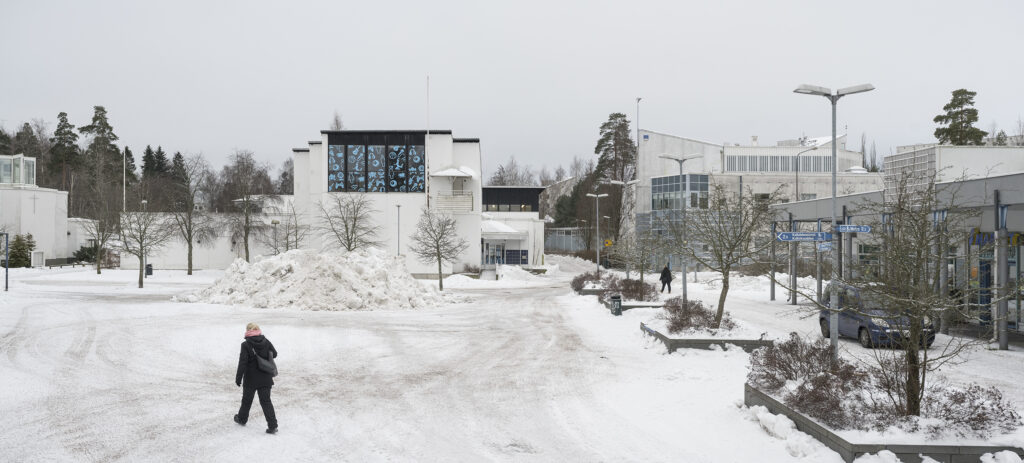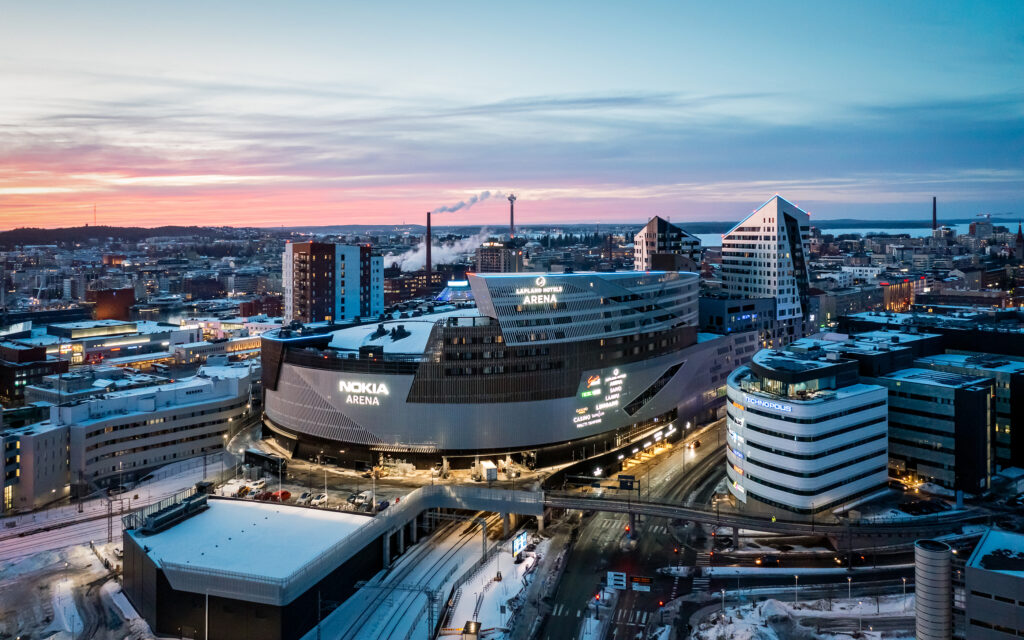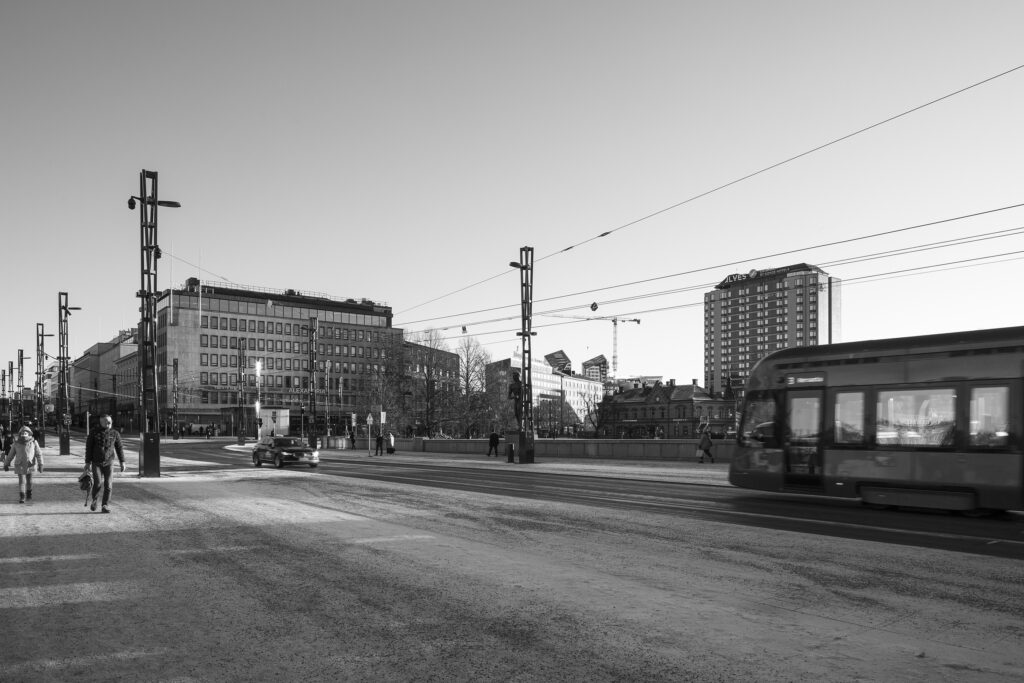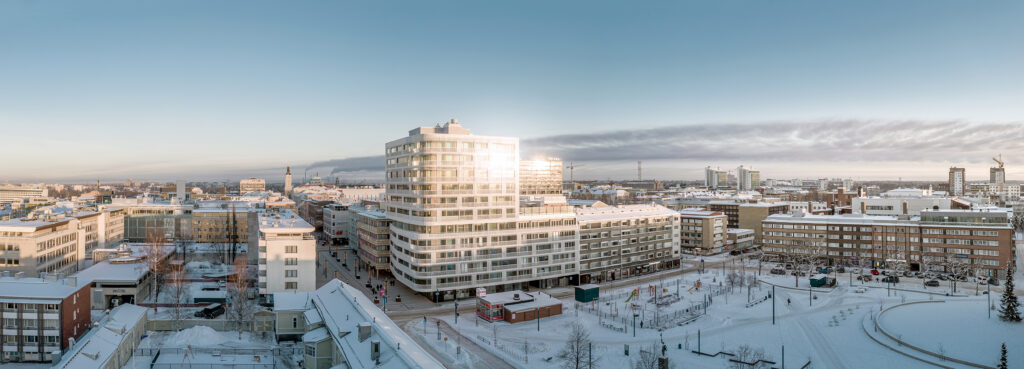Who Has a Right to the City?
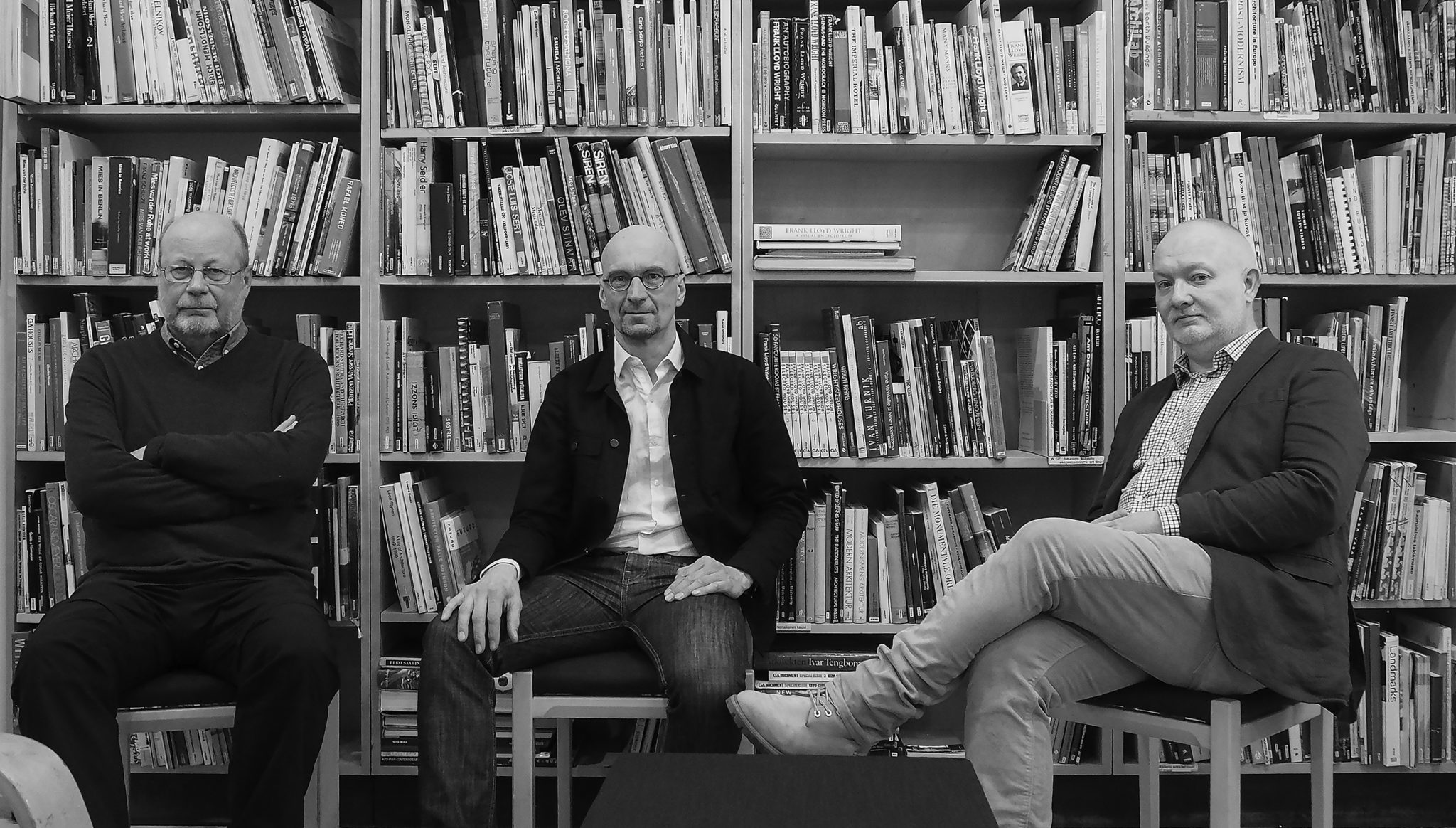
Recently, there has been an active discussion about whether Helsinki is planned on the terms of investors or city residents. We discussed the sore spots of city planning with the editors of the pamphlet Kenen kaupunki? (“Whose city”), Harri Hautajärvi, Juhana Heikonen and Timo Tuomi.
ARK / Kristo Vesikansa Behind the book project are four communities in the built heritage sector: Docomomo, ICOMOS, Rakennusperintö-SAFA, and the Finnish Architectural Society. Could you tell us how the book project began and what was your motivation for it?
Juhana Heikonen It all started at a meeting organised by these four communities in August 2020, where it was discussed what is happening to valuable cultural environments in Helsinki and throughout Finland. A spontaneous idea was created: it would be necessary to come up with some kind of publication on the matter.
Timo Tuomi At the meeting, we discussed the matters that could still be done, and the last alternative was a pamphlet raising the profile. At the end of the day, everyone agreed that it was worthwhile making it as a joint effort.
Harri Hautajärvi This is the first concrete example of a way of thinking that has become commonplace lately: the organisations in the building preservation sector should start working together.
Tuomi We have noted that every society and association has to tackle individual problems, but no-one manages the big picture. However, it must also become visible.
The City receives temporary income from the sale of building rights, but the residents and their shared interests suffer.
ARK In the past few years, the city planning of Helsinki has been characterised by rapidly increasing floor area ratios. In your opinion, what is the reason for this change?
Hautajärvi In my view, it deals with three key factors: the migration flow to centres of growth, a straightforward densification ideology that is based on a misunderstanding, as well as a phenomenon in which city planning and construction have become investment operations.
Heikonen Above all, the role of dwellings as financial instruments has been further emphasised. It could almost be called a change of paradigm. Furthermore, the changes that have taken place in political power relations have also had a large effect: during the three latest terms of office of Helsinki City Council, the Greens have replaced the Social Democrats as the second largest group in the council. At the same time, an administrative and organisational reform was carried out in the City of Helsinki, which promoted the execution of a new kind of land use policy.
Hautajärvi A local master plan that was ratified in 2016 is a milestone in the intensification measures, as the local master plan is entirely based on the densification ideology.
Heikonen Many experts find that the calculation criteria for the local master plan are incorrect and tendentious. When looking back in time, none of the previous population projections have been accurate. What would make the current population projection accurate? According to politicians, several of the forecasts are also political, i.e. politicians seek to put them into practice.
Hautajärvi This cannot be about forecasting, but enabling: how many new residents are wanted within the borders of Helsinki? In the local master plan, the objective is 250,000 new residents by the year 2050, and the intention is to make room for these people and build dwellings for them.
ARK You referred to the phenomenon that the interests of property investors increasingly steer the city planning. How can it be seen in the planning of the inner city of Helsinki?
Heikonen First of all, it can be seen as allocations of large areas in connection of which no bidding competition was organised or it was insufficient. The latest case is a seven-hectare planning reservation on the rocks of the Alppila district that the City of Helsinki allocated to the construction company NCC. Earlier on, the City of Helsinki would have zoned it and sold the plots. Today, these areas are allocated, without any discussion or democratic decision making, as a large bunch, to construction companies that cooperate with various financial institutions, or directly to property investors – the one who is the first to make the reservation. Companies are also in charge of the planning of the areas. It is particularly problematic that the reservations are made on land that is owned by the City of Helsinki. These reservations have become increasingly common over the past three terms of office of Helsinki City Council, and we are talking about hundreds of thousands of gross floor square metres.
Hautajärvi The City of Helsinki receives temporary income from the sale of building rights, but the residents and their shared interests – the cityscape and pleasant environment – suffer. All of this deals with the common thread through our book, i.e. the cultural environment. At the present time, many of the most valuable cultural environments in Helsinki are being spoiled by additional construction.
Leading politicians justify the destruction of historical environments by claiming that it is a high time to make bold decisions. It isn’t boldness. It is bold to say that Helsinki is Helsinki and this is fine.
ARK It has been proposed that one reason for the change that has taken place in the city planning of Helsinki is that the role of architects and other experts has decreased in decision-making. Do you think this claim is true?
Heikonen Yes, it definitely is. If we take a look, for instance, at the professional images of the directors and managers in the Urban Environment Division, there are only a few architects. Currently, most of the employees in the division only have some experience in cultural environments and their preservation. In addition, the replacement of the cityscape advisory board with a considerably smaller unit that has less power is a sign of a decreased influence of architects.
Hautajärvi Many architects’ offices that have been regarded as being very competent have, lately, become assistants for capital investors and construction companies. In the largest property investment projects, architects aren’t allowed to affect the size of the projects either in the planning or building design phase. All that remains for architects’ offices is to make the gigantic gross floor square metres feasible and even defend poor designs.
ARK At the present moment, more buildings are being torn down in Helsinki than in many decades, particularly post-war building stock. Is it reasonable to draw parallels with the current situation and a demolition wave that took place in the 1960s?
Tuomi The demolition wave comes, but in a new form. During the 1960s, a large number of buildings were torn down, but now, in addition to the demolition, they currently deal with squares and market places as construction sites, which are shared empty spaces that are important for the residents. Leading politicians justify the destruction of historical environments by claiming that it is a high time to make bold decisions. It isn’t boldness. It is bold to say that Helsinki is Helsinki and this is fine. I wonder if there are any studies in which foreign companies would have been asked what they value in Helsinki? I believe that they don’t appreciate the same things being constructed here as elsewhere. In global competition, the pull factors of Helsinki aren’t new start up campuses, but the other things we have and how they are refined.
Hautajärvi In the current demolition mania, we lose a great deal of resources by tearing down usable buildings; at least their reinforced concrete frames could be saved. To crown it all, the demolition and replacement of buildings with new ones are being justified as being a climate action. New buildings are claimed to be more energy efficient, even though their overall energy consumption may be larger than that of the buildings that are demolished.
We, by no means, oppose development. We want to get involved in which ways new areas are constructed and old urban areas are made better.
ARK When published, the book will, no doubt, arouse discussion and opposite opinions. What is your answer to those who think that you object to a natural reformation of the city?
Hautajärvi We, by no means, oppose development. We want to get involved in which ways new areas are constructed and old urban areas are made better. The premise should be the characteristics and identity of Helsinki. This objective appears to be crushed now, as city planning is allocated to construction companies and capital investors. We should openly discuss which values are used for the planning and building of Helsinki.
ARK The book focuses on changes taking place in Helsinki and in its inner city, in particular. Can the trends that dominate here be generalised to the other parts of Finland, or is Helsinki a special case?
Hautajärvi The same phenomena can also be observed in the other centres of growth. For instance, in Oulu, construction and investment companies have influenced the city planning for a longer time. It can be seen as an increasing number of tall and massive buildings and the raising of protected buildings. A central street in the grid plan designed by architect Carl Ludvig Engel was cut off, as they wanted to extend the shopping centre there. There is enthusiasm for the construction of towers, even in small towns.
ARK And what does the development of Helsinki look like in an international context?
Heikonen Romans have managed to preserve their city very well. It is said that Rome is a museum, but it has three million inhabitants. In Germany, neither, there aren’t excessively tall buildings in cities, except for Frankfurt and a few other exceptions. In particular, the older cities have insisted on the preservation of the medieval church towers as the landmarks that can be seen first when approaching the city.
Hautajärvi In London, however, capital investors and construction companies have received the power and the city planning has almost fallen apart. A huge number of skyscrapers have risen in London, and the pressure is the same in Paris. There are severe disputes on these matters in both cities.
ARK The book will be published just before the municipal elections that are held in April. What kind of opportunities do you think architects and experts of built environment have to influence political decision making?
Heikonen Right now, it looks bad, as the best-known politicians in Helsinki question the expertise in public discussion. It is necessary to involve more of such people who are also able to approach city planning from other perspectives than the numerical perspective. In addition, in recent projects, it has become more common to rhetorically say that the projects have been prepared in cooperation with the museum authorities, even though the statement of the museum authorities would have been negative for the project. This way, expert statements are distorted.
ARK In recent years, architects and the Finnish Association of Architects SAFA have expressed their views more actively than before regarding topical planning and construction projects. This has also been objected to amongst architects. In your view, what is the best way to influence matters?
Hautajärvi Architects and SAFA have expressed their views regarding design and construction since the late 19th century, and it has had an important effect on the development of Finland. We are still obliged to express our views as experts and refer to research data when justifying our views. For instance, tall and dense construction is now defended in Finland, saying that it is a climate action, even though its impact is the opposite, as the energy consumption is relatively higher and the urban heat island phenomenon is stronger.
ARK What kind of Helsinki do you hope to see in ten or twenty years of time?
Heikonen I hope to see a Helsinki that appreciates more the existing cultural environment and its good features. It is never possible to preserve everything, but the current approach cannot be the right one.
Tuomi Helsinki should be a pioneer in development and not lag behind in the same way as others.
Hautajärvi We should discuss in what kind of a city people want to live in the future. For instance, Puu-Käpylä and Kumpula are highly valued wooden house districts, where it is pleasant to live and where residents carry out urban agriculture. Puu-Käpylä and Kumpula, together with the large perimeter block built by the company Kone & Silta Oy in Vallila, could be good examples for future city districts. It is very important that people enjoy themselves in their dwellings and residential areas now that remote working at home is becoming increasingly common. ↙
Harri Hautajärvi, Juhana Heikonen, Petteri Kummala ja Timo Tuomi (eds.): Kenen kaupunki? Helsingin kaupunkisuunnittelu ja kulttuuriympäristö törmäyskurssilla, Docomomo Suomi Finland, ICOMOS Finland, Rakennusperintö-SAFA, and the Finnish Architectural Society, 2021.
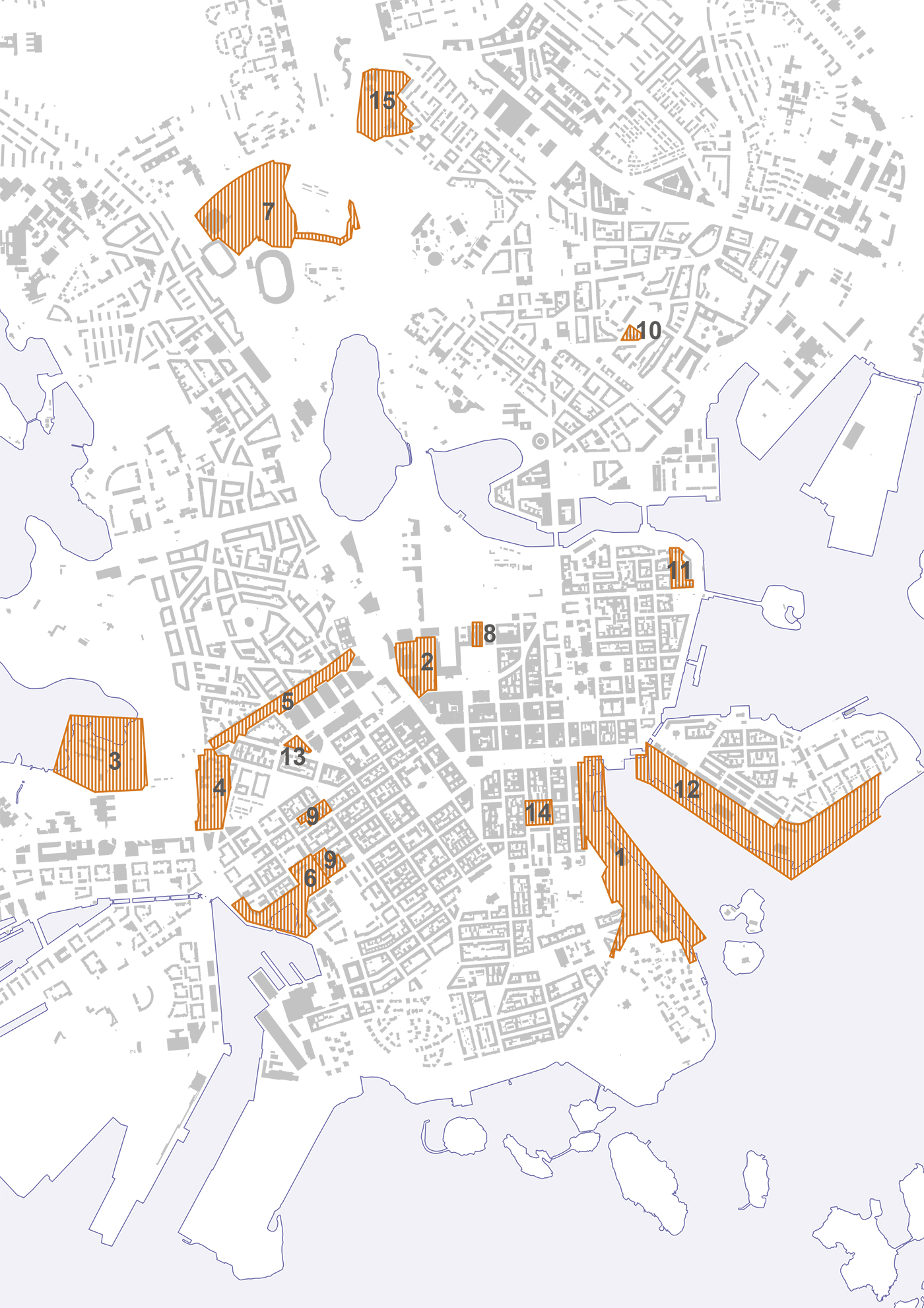
1) Eteläsataman länsirannalle on suunnitteilla suuria liiketalokortteleita sekä uudisrakennus arkkitehtuuri- ja designmuseolle.
2) Elielinaukiolle ja Asema-aukiolle on suunnitteilla suuri toimisto- ja liiketilahanke
3) Lapinlahden suojellun sairaala-alueen täydennysrakentamisesta laaditaan uusia ehdotuksia.
4) Marian sairaalan eteläosan suojellut rakennukset on tarkoitus purkaa ja siirtää uuden toimistotalon alta.
5) Eteläiselle Rautatiekadulle, suositun pyöräilyreitti Baanan yhteyteen, on ehdotettu hotellia, liike- ja toimistotiloja sekä asuntoja.
6) Hietalahdenrannan kehittämissuunnitelma sisältää toimistotalon, autoliikenteen väylän ja parkkiluolan Hietalahden torin alle.
7) Keskuspuiston viereen rakennettava Helsinki Garden -hanke sisältää maanalaisen tapahtuma-areenan, liikunta-, liike- ja toimistotiloja, hotellin ja asuntoja.
8) Osa suojellusta Kansallisteatterin rakennuksesta on tarkoitus purkaa ja korvata uusilla tiloilla.
9) Metropolian arvokkaat koulukiinteistöt muutetaan asunnoiksi, toimistoiksi ja hotelleiksi ja niihin tehdään laajennuksia ja lisärakennuksia.
10) Arkkitehtonisesti arvokas teollisuuskoulu Torkkelinmäellä muutetaan vuokra-asunnoiksi ja sisäpiha peitetään uudella siipirakennuksella.
11) Uudenmaan pataljoonan kasarmikorttelin sisäpihalle suunnitellaan uusia kerrostaloja ja maanalaista pysäköintilaitosta.
12) Katajanokan etelärannalle on suunnitteilla uusia toimisto- ja asuinkortteleita.
13) Kampintorin hotellia on tarkoitus laajentaa siten, että se peittäisi osittain kaupunkikuvassa suojellun Helsingin synagogan.
14) Kasarmitorin liikerakennus on tarkoitus purkaa ja korvata huomattavasti suuremmalla toimistorakennuksella.
15) Alppilan kallioille on suunnitteilla uusia toimisto- ja asuinkortteleita.

